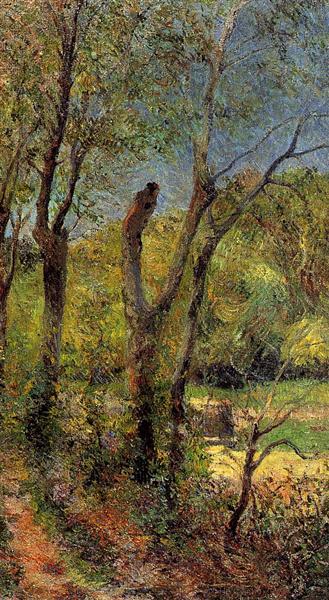Description
Paul Gauguin's painting "Willows", painted in 1885, reflects a crucial stage in the evolution of one of the most important post-impressionist artists. This painting transports us to a corner of nature where the willows, with their long branches leaning towards the water, offer a serene and melancholic spectacle. Gauguin, who was noted for his bold chromatic and compositional explorations, here presents a work that lies at the intersection of Impressionism and a future, more symbolic and personal approach to painting.
The composition displays an almost abstract approach to the depiction of the landscape, characterized by a harmonious fusion between the willows and the natural surroundings. The shapes are simplified, while the vibrant, saturated colors reverberate with an intensity that uniquely captures the light. The palette employed by Gauguin is rich in nuances, with deep greens evoking the freshness of the foliage and blues that seem to reflect the sky. This interplay of colors not only beautifies the work, but invites the viewer to immerse themselves in an almost contemplative state.
In this painting, the willows are not just decorative elements; their shape and arrangement create a visual dialogue that guides the viewer through the canvas. This emphasis on nature and the emotional space it evokes prefigures a more symbolic style that Gauguin would develop in his later works, especially during his time in Polynesia. The way the branches intertwine and fall towards the water seems to suggest a deep connection with the land, where the tangible and the ephemeral intertwine.
It is interesting to note that in "Willows", unlike many other works by Gauguin from the same period, there is no visible human presence. This absence of human figures suggests a distancing from the busy life of the city and a celebration of the peace that nature offers. In many ways, the painting can be interpreted as a reflection of the artist's personal quest, which eluded modern society in favour of the simplicity and tranquillity provided by the natural environment.
The work also reveals Gauguin's transition towards a more distinctive and expressive use of colour. Although Impressionism had emphasised naturalistic light and colour, here Gauguin begins to develop a visual language of his own that transcends the limitations of the time. The use of colour not only describes the physical world, but also acts as a medium to express deeper emotions and feelings.
In conclusion, "Willows" is a work that embodies both Gauguin's stylistic transition and his intense relationship with nature. When looking at this painting, one senses the artist's constant search to find his own voice in a world that was beginning to move at a dizzying pace. The simplicity and beauty of the landscape, caught in the dance of light and color, conjure an atmosphere that invites contemplation and aesthetic enjoyment, elements that still endure in the resonance of this masterpiece.
KUADROS ©, a famous painting on your wall.
Hand-made oil painting reproductions, with the quality of professional artists and the distinctive seal of KUADROS ©.
Painting reproduction service with satisfaction guarantee. If you are not completely satisfied with the replica of your painting, we will refund 100% of your money.

